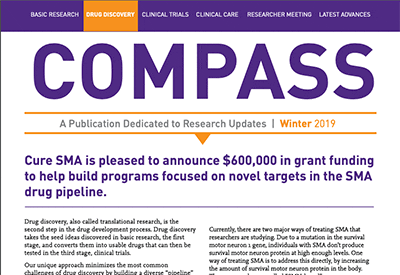At the end of June, SMA researchers and clinicians from around the world gathered in Anaheim, California, for the 29th Annual SMA Research & Clinical Care Meeting. Their common goals were to accelerate the pace of research into SMA treatments and to achieve excellence in SMA clinical care.
The annual meeting provides an opportunity for scientists, doctors, physical therapists, and other experts in SMA research and clinical care to share their most recent discoveries and insights. It also gives professionals from different areas of expertise in SMA a chance to form new partnerships.
Below are summaries of the presentations given at this year’s Basic and Clinical Research Sessions. Some of the most impactful new advances in SMA research are featured!
Be sure to keep checking our Latest News posts for upcoming summaries of more 2025 Basic and Clinical Research Sessions, as well as from the Clinical Therapeutic Development Session.
SMA is a genetic disease most often caused by the deletion of the survival motor neuron gene (SMN1). Deletion of SMN1 results in low levels of the protein it makes, the survival motor neuron protein (SMN). Without enough SMN protein, motor neurons fail to develop properly, are unhealthy, and die prematurely. Motor neuron death, in turn, results in the subsequent loss of muscle strength and function.
The SMN2 gene also produces the SMN protein and can act as a partial back-up when SMN1 is deleted. However, most of the SMN protein made by SMN2 does not function properly, so SMN2 cannot fully compensate for the deletion of SMN1. For this reason, each of the three currently approved disease-modifying therapies for SMA acts by increasing low SMN protein levels.
In addition to the SMN protein, many other proteins also play direct and indirect roles in the development, function, and survival of motor neurons. In Basic Research Session 1, investigators presented findings on some of these additional proteins, the parts they may play in motor neuron health, and how they may inform the development of future SMA therapeutics.
Podium Presentation 1. A synaptic chaperone modifies the SMA phenotype in the mouse model of the disease
Presenter: Narendra Nath Jha, PhD ~ Columbia University Medical Center, New York, USA
- Jha and his colleagues previously identified a protein variant called “Hspa8G470R” that lessened disease severity in an SMA mouse model.
- In their current work, Dr. Jha’s team found that in SMA mice without a functioning SMN2 gene, expressing the Hspa8G470R protein variant increased SMN protein levels through a mechanism that did not depend on the presence of SMN2. The mice also had a longer lifespan and better motor function than control mice.
- These findings suggest that the Hspa8 protein plays multiple roles in regulating SMN levels and may be a promising target for new SMA drugs.
Podium Presentation 2. Determining the role of SARM1-mediated axon degeneration in SMA
Presenter: Madeline Denton, BS ~ Johns Hopkins University, Maryland, USA
- Severe SMA is characterized by rapid motor neuron degeneration beginning early in brain development. The SARM1 protein is an important player in motor neuron axon degeneration.
- In this study, Ms. Denton and her colleagues explored whether genetic removal of the SARM1 protein in severe SMA mice prevented motor axon degeneration.
- Denton found that genetic removal of SARM1 was associated with short-term neuroprotection of small, immature SMA motor neuron axons during the neonatal period of brain development.
- The results from this study may have revealed a potential approach to protecting motor neurons from degeneration caused by SMA early in neurodevelopment.
Podium Presentation 3. DLC1-i1 rescues motor neurons in spinal muscular atrophy by enhancing SMN2 splicing and axon growth, offering a novel therapeutic strategy
Presenter: Tianyuan Shi, PhD ~ University of Hong Kong, China and University of California, USA
- Although SMN-enhancing therapies may slow or halt disease progression, they do not reverse motor neuron loss.
- In this study, Dr. Shi’s research group found that a protein called “DLC1-i1” is highly expressed in healthy mouse and human motor neurons, but its expression is much lower in motor neurons affected by SMA.
- The researchers also discovered that in SMA mice, high levels of DLC1-i1 combined with SMN-targeted gene therapy increased lifespan and motor function more than gene therapy alone.
- These results may inform the development of “add-on” treatments that can be used together with SMN-enhancing, disease-modifying therapies to achieve optimal outcomes for people with SMA.
Podium Presentation 4. Identification of KIF5A as a key factor linking axonal pathology in SMA and ALS
Presenter: Tetsuya Akiyama, MD, PhD ~ Stanford University, California, USA
- RNA is a chemical copy of a gene that contains precise instructions for how to make a specific protein. The SMN protein plays important roles in the way RNA is modified after it is copied, or transcribed, from genes.
- In his research, Dr. Akiyama and his fellow researchers investigated the consequences of reduced SMN protein levels on the expression of genes in human and SMA mouse neurons.
- The investigators discovered that low SMN protein levels significantly downregulated both the transcription and the expression of the gene, KIF5A. Low KIF5A protein levels in turn impaired axon regeneration, whereas restoring KIF5A levels counteracted the axonal growth defects caused by low levels of SMN.
- These findings suggest that KIF5A may serve as a novel target for SMN-independent SMA drugs.
Gene expression is the process by which the information encoded in a gene is used to produce protein. It begins when a gene's sequence is copied from chromosomal DNA into a molecule of RNA, called a transcript. This RNA transcript may then be processed into different isoforms—alternative versions of the RNA—through mechanisms like splicing. RNA is then translated into a protein, which carries out one or more functions in a cell.
The SMN protein has many important functions in motor neurons and other cells throughout the body. Some of those functions are known to be involved in aspects of gene expression such as RNA splicing. Researchers continue to learn more about how SMN regulates gene expression. In Basic Research Session 2, presenters shared what they have discovered about how low levels of the SMN protein affect gene expression in animal and human cells.
Presentation 5: Direct RNA nanopore sequencing reveals extensive transcript isoform diversity in control and SMA human iPSC-derived motor neurons
Presenter: Stephen Brown, BS ~ Johns Hopkins University, Maryland, USA
- In this study, Mr. Brown and his colleagues utilized a method called “long-read direct RNA sequencing" to characterize the RNA transcripts present in induced pluripotent stem cells (iPSCs) derived from people with and without SMA. iPSCs are a type of stem cell created in a laboratory from adult human cells. These basic cells can be genetically programmed to differentiate into specialized cells like motor neurons.
- The investigators found many differences between the RNA transcripts present in SMA and control cells, suggesting that low levels of the SMN protein cause widespread changes in RNA processing.
- These data add to researchers’ understanding of the myriad roles SMN plays in healthy cells, and how low levels of SMN cause motor neuron loss and other markers of disease in SMA.
Podium Presentation 6. Long-read sequencing reveals novel insights into SMN locus complexity in SMA
Presenter: Ewout Groen, PhD ~ University Medical Center Utrecht, Netherlands
- To expand scientists’ existing understanding of the genetic factors involved in SMA, Dr. Groen and his group analyzed DNA from 31 people with SMA using cutting-edge improvements in long-read sequencing technology.
- The researchers found evidence that may explain how SMN1 gene deletion might occur in many people with SMA, and they learned more about how the SMN2 gene is regulated. Finally, Dr. Groen and his fellow researchers discovered a previously unknown, disease-causing mutation that resulted in a deletion spanning both the SMN1 and SMN2 genes.
- These results expand the knowledge base regarding how changes in the SMN1 and SMN2 genes contribute to SMA disease pathology, with implications for carrier testing and genetic counseling.
Podium Presentation 7. Comprehensive spatial transcriptome analysis of spinal cord and surrounding tissues in normal and SMA model mice
Presenter: Elliot Androphy, MD ~ Indiana University School of Medicine, Indiana, USA
- SMA is characterized by motor neuron degeneration. Its broader impact across other cell types and tissues is not yet fully understood.
- Using a technique called “spatial transcriptomics,” Dr. Androphy and his colleagues mapped RNA expression within the spinal cord and surrounding tissues in normal and SMA model mice.
- In very young SMA model mice, widespread dysregulation of RNA expression was found most notably in motor neurons, but it also occurred in other cell subtypes, includingastrocytes (a type of brain cell that supports neurons), muscle, cartilage, bone, and fat tissue.
- These findings may support the development of therapeutics that address symptoms occurring beyond the central nervous system in people with SMA.
Podium Presentation 8. Identification of early symptomatic gene expression changes in motor neurons in a large animal model of motor neuron disease
Presenter: Megan Baird, PhD ~ The Ohio State University, Ohio, USA
- Although SMA mouse models are widely utilized in research, pig models offer distinct advantages for certain types of research as they more closely resemble the human disease.
- In prior research, Dr. Baird and her colleagues created an SMA pig model characterized by selective, progressive motor neuron degeneration like that seen in people with SMA.
- In the current study, Dr. Baird’s group used this SMA pig model to preliminarily characterize genetic, molecular, and electrophysiological changes that preceded motor neuron dysfunction and death.
- The development of new research tools like large animal models is vital to the acceleration of SMA research and drug development.
In the past decade, the dramatic increase in the availability of disease-modifying therapies for SMA has been accompanied by the widespread adoption of newborn screening. As a result, early diagnosis and treatment have markedly increased the life expectancy and quality of life of many infants with severe SMA. In Research and Clinical Care Session 1, investigators and clinicians focused on emerging questions about cognition and behavior in the growing population of children with severe SMA who received disease-modifying treatment as infants.
Podium Presentation 9. Investigating the developmental expression of SMN in the brain in a mouse model of spinal muscular atrophy
Presenter: Charalambos Demetriou, PhD ~ UCL Great Ormond Street Institute of Child Health, United Kingdom
- Demetriou’s research lab investigated whether severe SMA mice treated after birth with SMN-enhancing drugs demonstrated neurobehavioral characteristics that differed from untreated mice that had a mild SMA phenotype or from control mice.
- The group’s preliminary results indicated that, as adults, treated, severe SMA mice and untreated, mild SMA mice were both less aggressive and less social than control mice. Treated severe SMA mice were less responsive to non-social stress than were mild SMA mice and controls.
- These findings are a first step in the process of understanding if and how low levels of the SMN protein, and restoration of those levels through treatment, affect neurodevelopment.
Podium Presentation 10. PANEL DISCUSSION: Uncovering cognitive implications in spinal muscular atrophy: research gaps, clinical insights, and future directions
Panel Members:
Sarah Wright, DO ~ Children's National Hospital, Washington, DC, USA
Eduardo Tizzano, MD, PhD ~ Vall d’Hebron Institute de Recerca, Spain
Gretchen Weatherly, PhD ~ Gillette Children’s, Wisconsin, USA
In this session, panel members explored emerging evidence and key questions surrounding cognitive and neurodevelopmental outcomes in individuals with SMA. The panel discussed the role of SMN1 in brain development, reviewed current data on cognitive impairment across the lifespan in individuals with SMA, and evaluated the use and limitations of existing assessment tools in children with SMA.
Bulbar function includes activities such as communication, chewing and swallowing, and moving facial muscles. Although these functions have a large impact on quality of life, the effects of disease-modifying treatments on bulbar function have not been as well established as those on upper and lower limb motor functions. In Research and Clinical Care Session 2, investigators described how they used mouse models and humans to understand bulbar function in SMA and how it is affected by treatment.
Podium Presentation 11. Creating human hindbrain motor neurons: A platform to model bulbar symptoms in SMA
Presenter: Kyle Loh, PhD ~ Stanford University, California, USA
- Hindbrain motor neurons control muscles in the head that are involved in bulbar function.
- In this study, Dr. Loh discovered that during development, hindbrain motor neurons develop from different progenitor cells than do other brain cells.
- Loh and his colleagues then created hindbrain motor neurons using human pluripotent stem cells (hPSCs). An hPSC is an unspecialized cell that can be stimulated in the laboratory to differentiate into a more specialized cell type, like a motor neuron.
- This new experimental cell model may accelerate research into treatments that address unmet needs in bulbar function for people with SMA.
Podium Presentation 12. Defects of sensory-motor circuits - controlling facial muscles - may provide mechanistic insights into suckling and masticatory behavioral deficits in SMA mice
Presenter: Danny Florez-Paz, PhD ~ Columbia University, New York, USA
- In this study, Dr. Florez-Paz and his lab members investigated the health of the sensory-motor neuronal circuits involved in feeding behavior in infant SMA mice. They wanted to understand the progressive decline in feeding behavior they observed as the infant mice aged.
- The researchers found that by five days after birth, the mice had lost approximately half of the motor neurons that innervate a muscle that supports feeding behaviors. The remaining motor neurons were underdeveloped.
- Understanding how the muscles involved in feeding are affected in SMA may support the development of treatments that specifically target bulbar function.
Podium Presentation 13. Differences in swallowing physiology between pre- and post-symptomatically treated patients with SMA
Presenter: Katlyn McGrattan, PhD ~ University of Minnesota, USA
- McGrattan and her colleagues aimed to determine the effects of disease-modifying treatment on swallowing ability in infants with SMA who were treated with disease-modifying therapy.
- The group retrospectively analyzed data from 67 infants with SMA who underwent a swallow study as part of clinical care.
- Analysis revealed that infants who received disease-modifying treatment before symptom onset had significantly better swallowing physiology than those who received treatment after symptoms occurred. However, some infants within the presymptomatic treatment group continued to exhibit swallowing deficits.
- These findings support a large body of research indicating that presymptomatic treatment of infants with SMA is essential for optimal health outcomes.
Podium Presentation 14. Enhancing bulbar assessment in spinal muscular atrophy: A Rasch analysis of the International Bulbar Assessment Tool (iBAT) Pilot Study
Presenter: Sally Dunaway Young, PT, DPT ~ Stanford University, California, USA
- Reliable and validated clinical assessment tools are needed to assess bulbar physiology and function in people with SMA.
- Toward that end, Dr. Dunaway Young and her colleagues tested the reliability and validity of a clinical outcome measure called the “International Bulbar Assessment Tool (iBAT).”
- The researchers used statistical analysis to evaluate iBATs completed by 130 individuals with SMA and 105 caregivers. They concluded that with further refinement, the iBAT may be a useful measure of bulbar physiology and function in individuals with SMA.
- The development of clinical outcome measures like the iBAT supports efforts to standardize the assessment of bulbar function and physiology in people with SMA.
Podium Presentation 15. Aberrant angiogenesis, blood–spinal cord barrier compromise, and neuroinflammation in severe spinal muscular atrophy patient spinal cord
Presenter: Hazel Allardyce, PhD ~ University of Aberdeen, Scotland, United Kingdom
- Prior research in SMA mice has found abnormalities in cells that line the vascular system, which is the network of blood vessels that bring nutrients to tissues throughout the body.
- In his research, Dr. Allardyce used advanced methods of microscopy to examine tiny blood vessels in post-mortem spinal cord tissue from people with SMA.
- The researchers found evidence that toxic molecules had leaked from the blood vessels into the spinal cord tissues.
- Allardyce’s group concluded that this leakage of toxic molecules into the spinal cord may contribute to neuroinflammation in people with SMA.
- The results from this study suggest a need for research into new therapeutic strategies that can support the vascular system in people with SMA.
Podium Presentation 16. Premature differentiation of motor neuron progenitors renders motor neurons vulnerable in spinal muscular atrophy
Presenter: Zeynep Dokuzluoglu, MSc ~ German Center for Neurodegenerative Diseases (DZNE), Germany
- Expression of the SMN protein is highest during early development, before a baby is born. It declines sharply after birth as motor neurons become specialized cells, or “differentiate” from precursor cells.
- In their research, Mr. Dokuzluoglu and his colleagues aimed to determine if low levels of SMN protein cause changes in motor neuron differentiation.
- Using a novel neuromuscular organoid model and human stem cell lines, the group found that SMA motor neurons differentiated earlier than unaffected cells.
- These results reinforce the importance of giving disease-modifying therapies early in life, before symptoms begin.
Podium Presentation 17. Profile time course of motor unit regeneration and stability following administration of SMN-upregulating therapeutics
Presenter: Inga Partlova, MScR ~ University of Edinburgh, United Kingdom
- Loss of motor neurons in SMA disrupts communication at the neuromuscular junction, where the axons of motor neurons connect to muscle fibers.
- Partlova and her colleagues treated SMA mice with nusinersen shortly after birth to evaluate how treatment affected the health of neuromuscular junctions.
- The group found that treatment initially improved neuromuscular junction innervation, or connectivity between the motor neurons and muscle. However, the health of motor neuron axons declined over time.
- The researchers also presented preliminary evidence that treating SMA mice with a growth factor and nusinersen increased axon number and the number of connections made with muscle fibers.
- Together, these findings highlight a potential future role for combination therapy in people with SMA who continue to experience motor function declines following treatment with disease-modifying therapy.

What is the difference between basic research and clinical research?
Basic research focuses on understanding the biology and causes of SMA to identify the most effective strategies for finding new SMA drugs.
Clinical research focuses on determining the best ways to diagnose and treat people with SMA so that they can have the highest possible quality of life.


